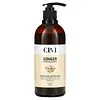What's inside
What's inside
 Key Ingredients
Key Ingredients

 Benefits
Benefits

 Concerns
Concerns

 Ingredients Side-by-side
Ingredients Side-by-side

Water
Skin ConditioningDisodium Laureth Sulfosuccinate
CleansingSodium C14-16 Olefin Sulfonate
CleansingCocamidopropyl Betaine
CleansingSodium Chloride
MaskingHydrogenated Poly(C6-14 Olefin)
EmollientPolysorbate 20
EmulsifyingZingiber Officinale Root Oil
MaskingZingiber Officinale Root Extract
MaskingHoney Extract
HumectantPropolis Extract
Skin ConditioningRoyal Jelly Extract
Skin ConditioningArgania Spinosa Kernel Oil
EmollientOlea Europaea Fruit Oil
MaskingSimmondsia Chinensis Seed Oil
EmollientPolyquaternium-10
Piroctone Olamine
PreservativeMethylpropanediol
SolventLaurylpyridinium Chloride
AntimicrobialAllantoin
Skin ConditioningCaramel
Cosmetic ColorantDisodium EDTA
Parfum
MaskingWater, Disodium Laureth Sulfosuccinate, Sodium C14-16 Olefin Sulfonate, Cocamidopropyl Betaine, Sodium Chloride, Hydrogenated Poly(C6-14 Olefin), Polysorbate 20, Zingiber Officinale Root Oil, Zingiber Officinale Root Extract, Honey Extract, Propolis Extract, Royal Jelly Extract, Argania Spinosa Kernel Oil, Olea Europaea Fruit Oil, Simmondsia Chinensis Seed Oil, Polyquaternium-10, Piroctone Olamine, Methylpropanediol, Laurylpyridinium Chloride, Allantoin, Caramel, Disodium EDTA, Parfum
Water
Skin ConditioningSodium Methyl Cocoyl Taurate
CleansingSodium C14-16 Olefin Sulfonate
CleansingLauryl Betaine
CleansingSodium Chloride
MaskingDecyl Glucoside
CleansingParfum
MaskingLauryl Hydroxysultaine
CleansingChamaecyparis Obtusa Water
MaskingLauryl Glucoside
CleansingXylitylglucoside
HumectantPolyquaternium-7
Anhydroxylitol
HumectantPPG-3 Caprylyl Ether
SolventPolyquaternium-47
Skin ConditioningPotassium Benzoate
PreservativeCitric Acid
BufferingXylitol
HumectantSaccharide Isomerate
HumectantCeramide AP
Skin Conditioning1,2-Hexanediol
Skin ConditioningSodium Benzoate
MaskingBiotin
AntiseborrhoeicCeramide NP
Skin ConditioningHydroxypropyltrimonium Hyaluronate
Sodium Citrate
BufferingSqualane
EmollientButylene Glycol
HumectantPentylene Glycol
Skin ConditioningCaprylyl Glycol
EmollientHydrolyzed Soy Protein
HumectantGlycoproteins
Skin ConditioningOligopeptide-2
Skin ConditioningWater, Sodium Methyl Cocoyl Taurate, Sodium C14-16 Olefin Sulfonate, Lauryl Betaine, Sodium Chloride, Decyl Glucoside, Parfum, Lauryl Hydroxysultaine, Chamaecyparis Obtusa Water, Lauryl Glucoside, Xylitylglucoside, Polyquaternium-7, Anhydroxylitol, PPG-3 Caprylyl Ether, Polyquaternium-47, Potassium Benzoate, Citric Acid, Xylitol, Saccharide Isomerate, Ceramide AP, 1,2-Hexanediol, Sodium Benzoate, Biotin, Ceramide NP, Hydroxypropyltrimonium Hyaluronate, Sodium Citrate, Squalane, Butylene Glycol, Pentylene Glycol, Caprylyl Glycol, Hydrolyzed Soy Protein, Glycoproteins, Oligopeptide-2
Ingredients Explained
These ingredients are found in both products.
Ingredients higher up in an ingredient list are typically present in a larger amount.
Parfum is a catch-all term for an ingredient or more that is used to give a scent to products.
Also called "fragrance", this ingredient can be a blend of hundreds of chemicals or plant oils. This means every product with "fragrance" or "parfum" in the ingredients list is a different mixture.
For instance, Habanolide is a proprietary trade name for a specific aroma chemical. When used as a fragrance ingredient in cosmetics, most aroma chemicals fall under the broad labeling category of “FRAGRANCE” or “PARFUM” according to EU and US regulations.
The term 'parfum' or 'fragrance' is not regulated in many countries. In many cases, it is up to the brand to define this term.
For instance, many brands choose to label themselves as "fragrance-free" because they are not using synthetic fragrances. However, their products may still contain ingredients such as essential oils that are considered a fragrance by INCI standards.
One example is Calendula flower extract. Calendula is an essential oil that still imparts a scent or 'fragrance'.
Depending on the blend, the ingredients in the mixture can cause allergies and sensitivities on the skin. Some ingredients that are known EU allergens include linalool and citronellol.
Parfum can also be used to mask or cover an unpleasant scent.
The bottom line is: not all fragrances/parfum/ingredients are created equally. If you are worried about fragrances, we recommend taking a closer look at an ingredient. And of course, we always recommend speaking with a professional.
Learn more about ParfumSodium C14-16 Olefin Sulfonate is a cleansing agent made from a mixture of long chain sulfonate salts. It can also help produce foam.
This ingredient may be drying. We recommend speaking with a professional if you have concerns.
Chances are, you eat sodium chloride every day. Sodium Chloride is also known as table salt.
This ingredient has many purposes in skincare: thickener, emulsifier, and exfoliator.
You'll most likely find this ingredient in cleansers where it is used to create a gel-like texture. As an emulsifier, it also prevents ingredients from separating.
There is much debate on whether this ingredient is comedogenic. The short answer - comedogenic ratings don't tell the whole story. Learn more about comegodenic ratings here.
The concensus about this ingredient causing acne seems to be divided. Research is needed to understand if this ingredient does cause acne.
Scrubs may use salt as the primary exfoliating ingredient.
Learn more about Sodium ChlorideWater. It's the most common cosmetic ingredient of all. You'll usually see it at the top of ingredient lists, meaning that it makes up the largest part of the product.
So why is it so popular? Water most often acts as a solvent - this means that it helps dissolve other ingredients into the formulation.
You'll also recognize water as that liquid we all need to stay alive. If you see this, drink a glass of water. Stay hydrated!
Learn more about Water